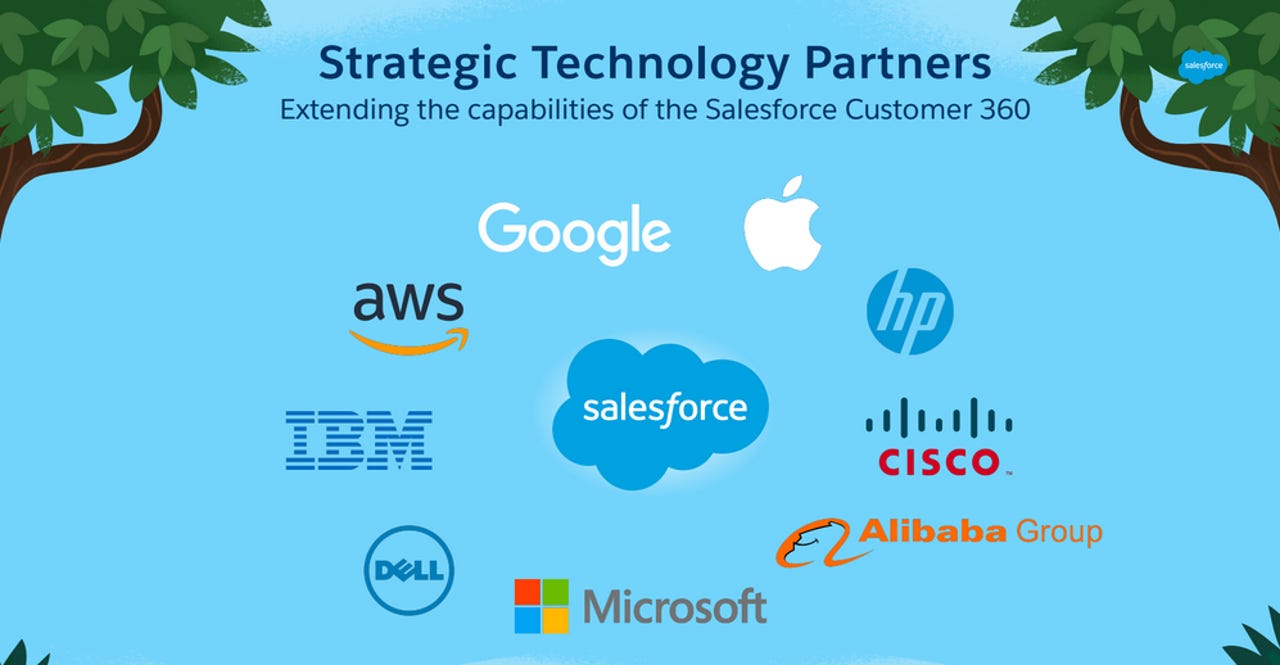At Dreamforce 2019, Salesforce tries to pull more data into its orbit

For years, Salesforce has touted the ecosystem that's developed around its cloud services. At Dreamforce 2019, the CRM giant gave the impression that it's not just facilitating the creation of new jobs or new workflows -- it's pulling existing business value into its orbit.
"We recognize as a community we're going to bring all of our partners in," Salesforce CEO Marc Benioff said during the Dreamforce keynote address. He stood in front of a screen displaying major tech industry players -- Microsoft, Apple, AWS, Google, IBM, HPE, Cisco, Dell, Abibaba -- with Salesforce in the middle.

"We have partnered with all the other major companies, and we are working to build a set of relationships," he said. "We realize you do have more than Salesforce, and we commit to you we will work with everybody. We will not create boundaries between us... We will operate as one community."
Working with everybody may be a stretch -- co-CEO Keith Block wouldn't even utter the name "Oracle" when referencing a Dreamforce event taking place at San Francisco's Oracle Park. He simply said it would be held at "the ballpark formerly known as AT&T park."
Still, Salesforce has enough pull with major customers to get its counterparts in the tech industry to take note.
"Salesforce is now is a $17 billion company with a significant enough center of gravity position in enough industries, in enough major companies like Macy's or Shell, where it can be the center -- the unifying force between all of these technologies -- even across technologies it doesn't own," Robert Mahowal, VP of applications research for G2, told ZDNet.
After generating around $17 billion in revenue this fiscal year, Salesforce told analysts last week that it expects to double that by 2024, with revenue coming in between $34 billion and $35 billion.
It plans to do that in part by getting more customers to use more than just one of its cloud offerings. Customers that use more than one cloud -- say, the Sales Cloud and the Service Cloud -- spend on average 20x more than single cloud customers, Salesforce told analysts at its Dreamforce Investor Day. So far, just 40 percent of its customers are using more than one cloud.
Salesforce is pushing its Customer 360 as a platform that can bring all of the clouds together.
Customers "really don't want point solutions," Block said at the investor day event. "They really want a simple platform that can bring all those things to bear."
Chris Zant, chief digital officer for ConvergeHEALTH at Deloitte Digital, said this approach makes sense from the perspective of the health sector, one of Saleforce's growing verticals. A "patient journey," much like a customer journey, could span multiple Salesforce clouds, he said.
"What I'm looking for this year is how does Salesforce enable those journeys across the platform and enable a more use case-driven model," Zant told ZDNet. "I don't care so much whether they're using the Marketing Cloud or Health Cloud, what I care about is how do I pick up a patient that needs help."
Salesforce's "multi-cloud" strategy will bring more data into the Salesforce orbit, but its new Customer 360 Truth is about pulling in data that sits outside of the Saleforce ecosystem. As an extension of its customer data platform, Customer 360 Truth promises businesses a "single source of truth" for customer data -- regardless of where that data resides. Customer 360 Truth leverages the Cloud Information Model, a new data model that standardizes data interoperability across cloud applications. Salesforce formed the CIM in partnership with Amazon Web Services, Genesys and the Linux Foundation's Joint Development Foundation.
"It really creates a standardized framework within the industry," Sean Huberty, SVP of Expedia's Travel Partners Group, told ZDNet. Huberty helps Expedia's lodging partners parse through available data to help them find new revenue or service opportunities -- for instance, whether a small hotel chain has an opportunity to capture more demand in certain markets.
"When you have standards across partners in ecosystem, it makes it easier for us to integrate data, so we know exactly how to match up to it," Huberty said.
While Amazon and Genesys helped launch the CIM, it's based on Salesforce technology -- more specifically, it's powered by tech from Mulesoft, the integration company that Salesforce acquired for $6.5 billion last year. It also sets up some competition for the Open Data Initiative, a similar effort launched a year ago by another trio of tech heavyweights -- Microsoft, Adobe and SAP. While the Open Data Initiative remains in private preview mode, as ZDNet's Mary Jo Foley reported, the CIM is open source.
"Data is an important part of everything we are doing and everything you are doing as our customers," Benioff said in his keynote address. "We can squarely say this fourth wave of computing is now upon us... We've moved from systems of record to systems of engagement… to systems of intelligence. Now we're moving from systems of intelligence towards something we've talking about for years – a single source of truth."